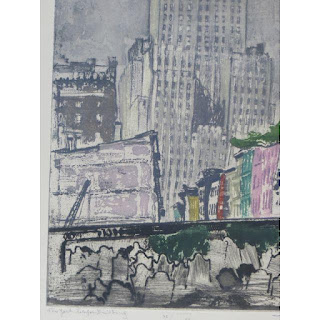Max Pollack's prints give us a sense of the world, and the similarity one can find in places close to home, or far away. I was attracted to an initial elegance and clunky-ness of his work. I do not mean the way Pollack draws, but there is something about the way he composes his images that one sees a well-lived in look to the buildings and street scenes. The way he colors the prints also has something to do with this, but I am most reminded of 19th c. prints of European cities and the cobblestones streets- an intimacy he finds in a cluster of shops.
Whether he chooses to show a mission church in San Francisco, or a skyscraper in New York, Pollack draws with an assurance for architecture. He gives us a glimpse into what attracted him on his numerous travels to Europe.
Pollack shows us buildings that have weathered the test of time, which tilting church bell towers and buildings that look like they are sagging and leaning into one another - like an older couple walking down a street who lean on one another for support. The buildings cannot survive without one another, and that makes them all the more appealing.
There are some loose connections one can draw to other urban artists like John Marin, though Marin's work is more Cubistic and fragmented. Pollack is tied to describing his subjects and the grandeur he sees in these urban settings. People are de-emphasized as we are supposed to look at the architecture - whether quaint or grand. I am pleased to see these works and wonder if I took a trip that I would find the same buildings in the same condition he described them. I would want to.
Max Pollak (1886-1970) was born in Prague, Czechoslovakia. His family later moved to Vienna, where he entered the Vienna Academy of Art. In 1912, he traveled to Italy, France, and Holland to continue his studies. During the World War I, he was appointed painter for the Austrian Army.
He immigrated to the U.S. in 1927, living in both New York and San Francisco where he traveled and produced a series of prints. He later traveled to Mexico and Guatemala.
During his career, Pollack produced over 500 prints, for which he won numerous awards.
Honors:
California Society of Etchers
Chicago Society of Etchers
Prix de Rome
Public Collections:
Achenbach Foundation for Graphic Arts
British Museum
de Young Memorial Museum
Judah L. Magnes Museum
Metropolitan Museum of Art
New York Public Library
Oakland Museum of California Art
Princeton University
Smithsonian American Art Museum









No comments:
Post a Comment